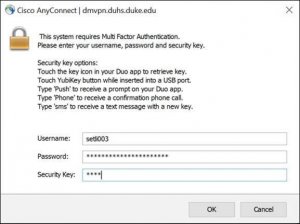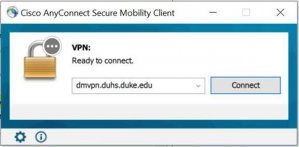Tech Tips: DUSON Guide to VPN
Duke’s VPN allows you to connect to the Duke Health Network from anywhere in the world and make it appear as if you are on campus. This is useful so you can remain productive anywhere. Here’s your guide to using the VPN.
Duke’s Virtual Private Network (VPN) is a software tool that does two things:
-
Duke’s VPN creates a pipe from your computer to a server at Duke’s data center that encrypts all data that passes between your keyboard and Duke. No one can see it – this is great for when you are traveling and/or are using public WiFi (hotel, Panera’s, airport, etc.);
-
When you connect via the VPN, you can access all Duke resources to which you have access, just as if you were on campus- from anywhere in the world where you can connect to the internet. This includes your P: and S: drives and other Duke resources such as Medical Center library collections.
Okay – what do I need to know …
Start here if you don’t know how to use the VPN or if you need a refresher:
-
There are two Duke VPNs – the University VPN and the Health System VPN. You need to connect to the Health System VPN. If you connect with the University VPN, you will not have access to Duke Health resources, such as the P: and S: drives, LearningSpace videos and library resources.
-
To connect to the VPN, you’ll need to have MFA installed and understand how to use it. If you don’t know how to use it, please contact your IT Service desk at SONIT-Support@duke.edu or call (919)684-9200.
-
If you’re using a Windows PC or a Mac, go to this location (software.duke.edu), search for and download VPN Client;
-
If you want to connect on an iPhone, iPad or Android device, go to the App Store or the Play Store and download Cisco AnyConnect.
How do I connect?
You can connect using almost any device. The screenshots below are from a Windows-based PC, but the process and information are consistent across devices even if the screens look different:

-
Open Cisco AnyConnect Secure Mobility Client
-
Enter dmvpn.duhs.duke.edu and press Connect; (first photo)
-
Enter your NetID and Password, then follow the Security key options; (second photo)
-
Press OK;
That’s it. Once you’ve successfully logged in with MFA, you have access to Duke resources. Don’t worry – if you have any problems or questions, just contact your IT Service Desk at SONIT-Support@duke.edu, or call (919) 684-9200.
FAQs …
Here are some answers to frequently asked questions. If you’re not finding what you need, be sure to ask your IT Service Desk Pros.
-
Do I have to use the VPN to access Duke resources when I’m off-campus?
-
Yes. It’s a secure way to work off-site, whether at home, on the road, on the beach, etc.
-
Use the VPN to access P:, S:, LearningSpace videos and Duke Heath Library resources
-
-
Do I have to use the VPN to access any of my course material in Sakai?
-
No. You’ll only need the VPN if your instructor tells you that you need it.
-
-
Do I need VPN to access Duke’s Box or OneDrive?
-
No. These are available without the VPN.
-
-
What if I’m using the Duke University network? Do I need the Duke Health VPN?
-
Yes. If you are using one of the campus networks (for example, at Krzyzewskiville or the Chapel), you’ll need to use the VPN to access your P: and S: drives, Learning Space videos and library resources.
-
-
I followed all of the steps above and I can’t connect? Is there any documentation?
-
Sure – here’s a link to the DHTS website (once you login, search for “Duke Health VPN” – select the first entry).
-
Or, just contact your IT Service Desk at SONIT-Support@Duke.edu or call (919) 684-9200.
-
As always, if you have any technical questions or problems, please contact your IT Service Desk at 919-684-9200, or email to citdl@mc.duke.edu.